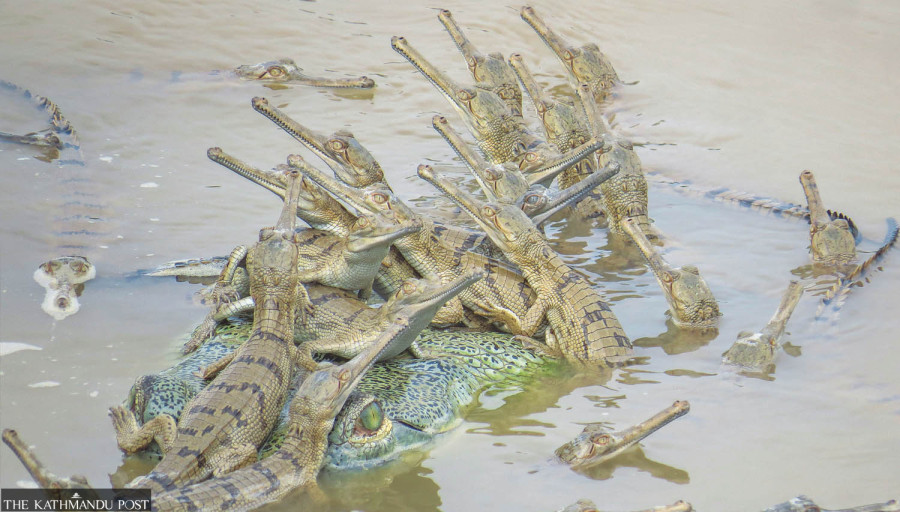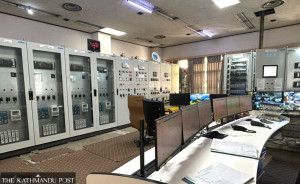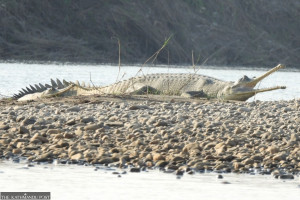Bagmati Province
Human activities pushing gharials to the brink
Only very few of the endangered species grow into adulthood as they have to struggle against various natural and, increasingly, manmade challenges.
Ramesh Kumar Paudel
To spot 110 baby gharials—a critically endangered species of crocodile—together in their natural habitat is extremely rare even for seasoned conservationists and nature lovers.
But anyone visiting the Dudhauraghat area along the Rapti river that cuts through Chitwan National Park these days could get a glimpse of this awe-inspiring sight wherein a giant female gharial looks after her babies.
Dudhauraghat lies around two kilometres south from the elephant breeding centre in Khorsor, Sauraha. The area is nestled amid the quiet of the forests, its peace interrupted only by the occasional chirping of the birds and the sound of the wild animals.
Phoebe Griffith, a British researcher who is doing her PhD on gharials, reaches the Dudhauraghat almost every day. She has installed some automated cameras in the area to record the breeding of gharials. The mother gharial hides the babies under water when Griffith goes near their habitat to take out memory cards and exchange batteries in the cameras. The mother gharial gets angry and attempts to attack her sometimes.
“It is great to see such a good number of babies of the critically endangered crocodile species,” says Griffith. “But only very few of them grow up as they have to struggle against various challenges of nature.”
Studies show that around one percent of the baby gharials bred in the natural habitats survive in India. But no such studies and research are conducted in Nepal. Griffith surmises that around 10 percent of gharials survive in the natural habitats in Nepal.
According to conservationists, there are several challenges to raising baby gharials. Some of them are swept away by floods while many others are attacked by some birds and other animals, says Prakash Bahadur Basnet, a resident of Sauraha who has been supporting researchers like Griffith for the past few years.
With the start of monsoon, water in Rapti river is gradually turning murky due to floods. And this—monsoon rains that trigger floods—are the main challenge for the baby gharials.
“The babies that are grown up in the mother’s care for about eight weeks can face the challenges of nature,” says Griffith. “But the river starts flooding before the baby gharials turn eight weeks.” But this time around, some of them were bred a few weeks ago, so Griffith is optimistic that more baby gharials will make it to adulthood.
According to conservationists, gharials are found in some rivers of Nepal, India and Bangladesh, with the Rapti and Narayani rivers being their major natural habitats.
The last century has been cataclysmic for the gharials of the world. The gharial population, which was estimated to be between 5,000 and 10,000 worldwide during the 1940s, declined by almost 96 percent to below 200 in 1976. This species—the only surviving member of the Gavialidae family—breeds only in the wilds of Nepal, India, Bangladesh, Bhutan, Myanmar and Pakistan. It is estimated that the current global gharial population is around 300–900.
For Basnet, it’s a cause for some solace that as many gharials have survived amid a flurry of natural and, increasingly, manmade challenges. Gharials are found only in clean flowing water and there should be a bit of sloppy river bank with good quality of sands to lay eggs, says Basnet, adding that the eggs are often destroyed by animals like mongoose.
“The mother gharials try their best to protect the babies from big birds, magar crocodiles and fish,” Basnet explains. “But who can save them from the floods in the river? I have been monitoring gharial breeding since 2018. I could find around 10 to 12 gharials that grew up over the time.”
The Chitwan National Park established a gharial breeding centre at Kasara in 1978, aiming to conserve the crocodile species by hatching its eggs and releasing them in the rivers when they grow up to two metres in length. The centre has seen some success. There were just 80 gharials in the country before the breeding centre was established.
The government authorities conducted nationwide gharial monitoring in 2016. A total of 198 gharials were found during the monitoring. Eighty-four gharials were recovered in the Narayani river, 82 in the Rapti river, 31 in the Babai river and one in the Karnali river.
According to Sarojmani Paudel, chief at the gharial breeding centre, a total of 1,692 gharials that grew up in the breeding centre have been released in various rivers as of now. However, the survival rate of those released gharials is not good.
The gharial has been enlisted as a protected species in Nepal. Conservationists say amid multiple challenges in gharial conservation, the most worrying are human activities, river pollution and depletion in number of fish.
The use of fishing nets that might trap gharials is another challenge in gharial conservation in the country. To counter this, Chitwan National Park has banned the use of fishing nets in the river. Conservationists say there’s some consolation to take from this but it’s not nearly enough to increase the population of this imperiled species.




 10.12°C Kathmandu
10.12°C Kathmandu1.jpg)










%20(1).jpg&w=300&height=200)

